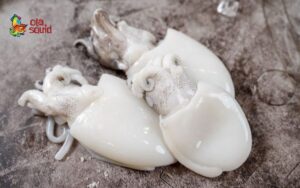Squid is a nutrient-rich ingredient that can be prepared into many attractive dishes such as stir-fried squid, grilled squid, steamed squid, etc. However, not everyone knows the how to prepare squid properly, effectively remove the fishy smell, and preserve it correctly after pre-processing. If you are also wondering, don’t miss the detailed instructions in the article below!
1. Identifying common fresh squid types
Understanding the characteristics of each type of squid will help you choose the right ingredient for each dish, as well as enhance the flavor of your family meals. Here are the commonly used fresh squid types:
- Cuttlefish: Thick fins, hugging almost the entire body to form an oval shape. This type of squid has a large body, thick, crispy, and naturally sweet meat. When grilled, it will emit a characteristic aroma, and the more you chew, the sweeter it becomes.
- Squid: Long, tube-shaped body, skin with many light pink spots, the head has 2 long tentacles and many small arms. Squid has a moderate size, firm, chewy, and crispy meat, very suitable for steaming, deep-frying, breaded frying, or stir-frying with vegetables.

- Cuttlefish: Oval-shaped body, with a thin, hard bone inside. This type of squid is usually large, with white meat, thick fibers, crispy but a bit bland. Small cuttlefish are often used for hot pot, salads, or steaming.
- Roes squid: Small squid, with a long, slender body like squid, caught during the breeding season, so the abdomen is full of eggs. When cooked, the eggs inside are soft, smooth, and fatty, combined with the crispy and fragrant squid meat, creating a special flavor.
- Sim squid: This is the smallest type of squid, with adult ones only as big as two fingers. The squid body is long and slender, which may or may not contain eggs inside. This type of squid has a very high natural sweetness, and when steamed to perfection, it retains a light, soft, and fragrant flavor without being greasy.
2. Instructions on how to clean squid
Cleaning squid properly not only makes the dish delicious but also preserves its inherent characteristics. Here are simple yet very effective steps:
- Step 1 – Pull out the head and remove the innards: After rinsing the squid briefly with clean water, hold the body with one hand and gently pull with the other to remove the head from the body. Next, insert your hand inside the squid’s belly to remove all the innards, the white spine, and internal organs. If you accidentally break the ink sac, rinse the squid thoroughly under running water to remove any ink clinging to the surface.
- Step 2 – Remove the eyes and beak of the squid: Use a knife to cut off the squid’s eyes and the hard white beak located between the squid’s head. You can also gently squeeze with your fingers to remove the beak.
- Step 3 – Peel the skin and clean the squid’s belly: For large squid like cuttlefish or cuttlefish, you need to remove the outer skin to make the dish tastier.
- Use a sharp knife to make a light cut along the length of the squid’s body to separate the skin from the flesh.
- Hold the squid body firmly with one hand, and use the other hand to gently pull to peel off all the skin.
- Then, slit the squid’s belly lengthwise, use a knife or spoon to scrape off any remaining innards and dirt inside to ensure the squid is not fishy when cooked.

- Step 4 – Rinse and cut into pieces: Finally, rinse the squid multiple times until the water runs clear. Drain and cut into bite-sized pieces if needed.
3. How to remove the fishy smell from squid
No matter how fresh the squid is, the characteristic fishy smell of seafood is hard to avoid. If you still smell a fishy odor after rinsing, try applying these simple tips using ingredients readily available in your kitchen to completely eliminate the unpleasant smell:
- Rinse with diluted salt water: Rinsing the squid with diluted salt water helps remove dirt and effectively reduce the fishy smell, while also quickly cleaning the surface of the squid.
- Soak with ginger and white wine: Combine a few slices of fresh ginger with a tablespoon of white wine in water, soak the squid for about 5 minutes, then rinse with clean water. This method thoroughly removes the fishy smell while keeping the squid meat crispy, delicious, and fragrant when cooked.
- Soak in green tea: If you have green tea or fresh tea water, you can soak the squid for 10 minutes. This method helps eliminate the fishy smell and keeps the squid meat looking bright white and more appealing when cooked.
4. How to preserve fresh squid after cleaning
After cleaning fresh squid, you can refer to the following two preservation methods, depending on your conditions and desired usage time:
- Preserving squid without refrigeration can keep it for about 8-10 hours:
- Place the pre-processed squid in a plastic bag or sealed container.
- Use a styrofoam box with small holes at the bottom for drainage, place a layer of ice at the bottom, then place the squid on top and cover with more ice.
- Preserving fresh squid for a long time in the refrigerator while maintaining its freshness:
- Remove the innards and skin, rinse with water (no need to rinse with salt water if not cooking immediately).
- Place the cleaned squid in an airtight container or zip-lock bag, vacuum-sealed bag, and store in the freezer compartment of the refrigerator.
- When needed, simply leave the squid at room temperature for about 25-30 minutes to thaw naturally.
Above are detailed instructions on the how to prepare squid cleanly, how to remove the fishy smell, and how to preserve squid. In addition, you can refer to many other delicious dishes made from squid suggested on the website to diversify your meals and retain the fresh flavor. We hope this article has been helpful to you, and for more interesting information about dried squid and fresh squid, don’t forget to visit the website olasquid.com!


 Tiếng Việt
Tiếng Việt ไทย
ไทย




